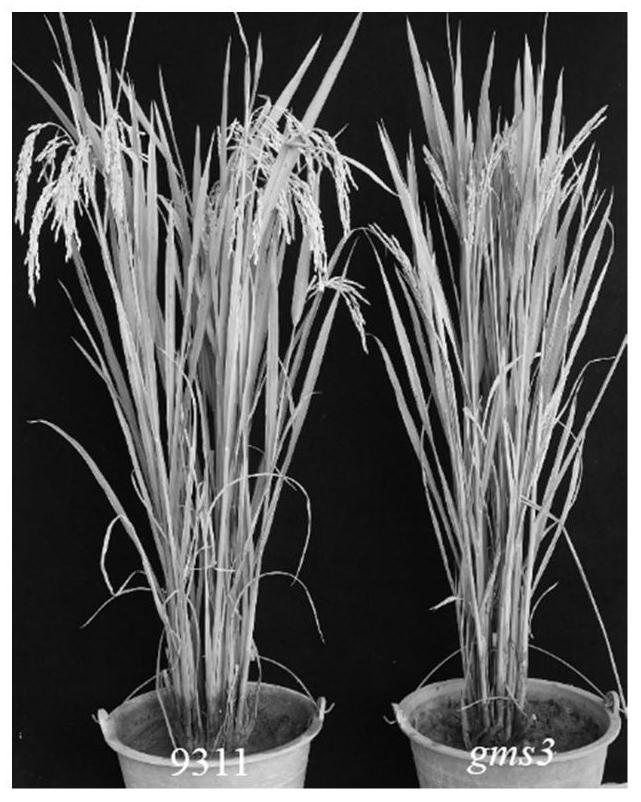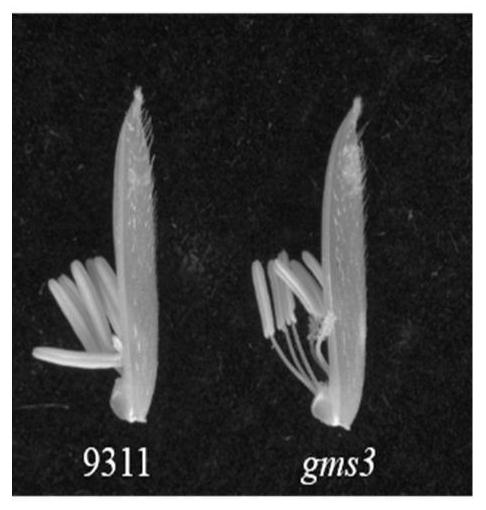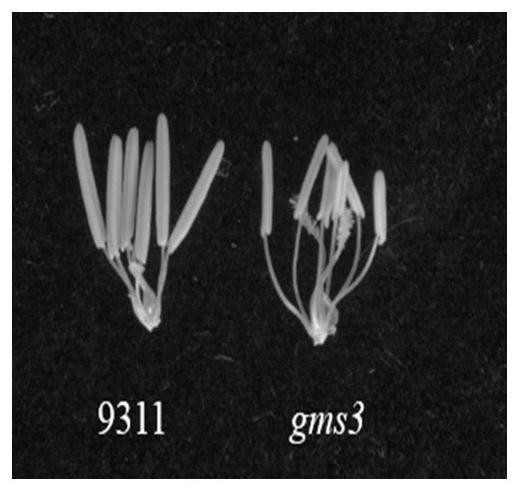Rice fertility regulation gene GMS3 as well as mutant and application thereof
A mutant, rice technology, applied in the application, genetic engineering, plant genetic improvement and other directions, can solve the problems of geographical limitation of seed production, high seed production risk, fertility affected by light and temperature environment, etc., and achieve the effect of stable sterile traits
- Summary
- Abstract
- Description
- Claims
- Application Information
AI Technical Summary
Problems solved by technology
Method used
Image
Examples
Embodiment 1
[0088] Example 1 Screening of rice male sterile mutant gms3
[0089] 10 kilograms of dry seeds of indica rice 93-11 were sent to the Hunan Academy of Agricultural Sciences for irradiation with cobalt 60, and the total radiation dose was 250 roentgens (Gy) to obtain M 0 It was planted in the Lingao Xinying base, and harvested separately after maturity, with a total of M 1 Substitute about 6000 copies of materials. The M1 generation material with more than 100 seeds was planted into a line, a total of 3500 copies, and 50 individual plants were planted in each line. Various types of mutants such as plant type, panicle type, fertility and yield were screened at tillering stage, booting stage, heading stage, flowering stage and grain-filling stage, and were harvested and stored. One of the mutants, 1199, exhibited male sterility and was named gms3.
Embodiment 2
[0090] Example 2 Phenotypic analysis of rice male sterile mutant gms3
[0091] Compared with wild type, gms3 mutant plants ( figure 1 ) and spikelets ( figure 2 ) in normal form, with a slightly late flowering. The floret morphology of the mutant was observed under a stereomicroscope, and it was found that the anther of gms3 was thinner and lighter than the wild type ( image 3 ). With iodine-potassium iodide solution (0.6% KI, 0.3% I 2 , w / w) solution stained the pollen, the mutant pollen grains were small, few, irregular and could not be stained ( Figure 4 ), while wild-type pollen grains were large, round and stained blue-black ( Figure 5 ). The wild-type plants of the same family were normally seed-bearing after bagging, but the gms3 mutant was not seed-bearing. However, using rice variety 93-11 as the male parent to pollinate the gms3 mutant can produce fruit. This indicates that the mutant is a male sterile mutant.
Embodiment 3
[0092] Example 3 Genetic analysis of rice male sterile mutant gms3
[0093] In the M4 generation, 1321 isolates of gms3 were planted, of which 996 were normal in fertility and 325 were sterile. The segregation ratio of fertile and sterile plants was in line with 3:1 (χ 2 =0.08, P2 =1.06, P<0.05). The above results indicate that the sterility trait of gms3 is controlled by a recessive single gene.
PUM
 Login to View More
Login to View More Abstract
Description
Claims
Application Information
 Login to View More
Login to View More - R&D
- Intellectual Property
- Life Sciences
- Materials
- Tech Scout
- Unparalleled Data Quality
- Higher Quality Content
- 60% Fewer Hallucinations
Browse by: Latest US Patents, China's latest patents, Technical Efficacy Thesaurus, Application Domain, Technology Topic, Popular Technical Reports.
© 2025 PatSnap. All rights reserved.Legal|Privacy policy|Modern Slavery Act Transparency Statement|Sitemap|About US| Contact US: help@patsnap.com



